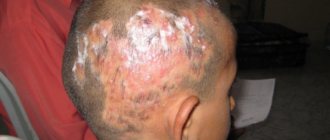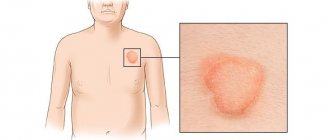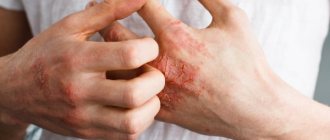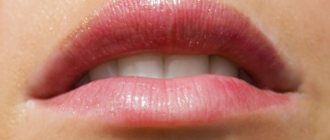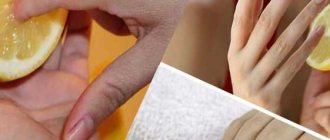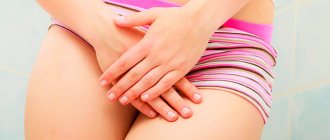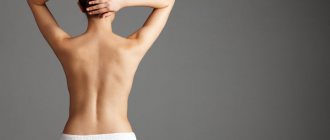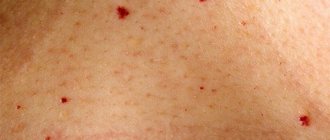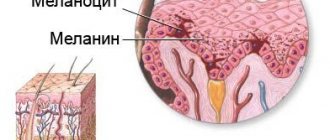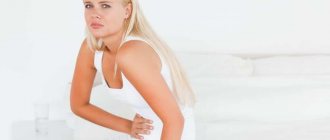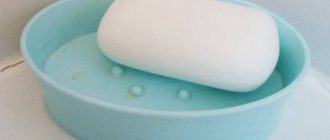Ringworm is a dermatological disease of various etiologies, in which papules, nodules, rashes and scaly spots appear on the body. To get rid of lichen on the body, therapy is carried out taking into account its type and cause of development. Standard treatment lasts 1-3 weeks. If the patient has a weak immune system, therapy is prescribed for 2 months. The scheme includes medications in different forms of release.
What is lichen
Skin diseases caused by various pathogens and manifested by specific elements of rashes are characterized by the term lichen. The exact cause of the appearance of a small nodular itchy rash has not been established, but the main factors that provoke skin lesions have been identified:
- the presence of a chronic viral infection in the body (mainly herpes);
- depressed immunity;
- pathologies of the endocrine system, diabetes mellitus;
- individual characteristics of the body, predisposition to allergic reactions;
- hypothermia;
- reaction to taking medications;
- exhaustion of the body due to increased emotional or physical stress;
- failure to comply with personal hygiene rules.
Infectious lesions of the skin are transmitted through tactile contact with an infected person or animal, so it is important to promptly identify lichen and begin adequate treatment to prevent infection of your loved ones. Common symptoms for dermatological diseases of this group are:
- the appearance of pigmented spots on the surface of the skin (plaques can be dark or light);
- the affected area begins to peel off;
- redness of the affected skin is observed;
- itching appears (of varying intensity, depending on the type of lichen);
- hair begins to fall out intensively at the site of plaque formation;
- general health remains unchanged.
Along with the general signs of the disease, specific symptoms may occur that are characteristic of the type of pathogen that provoked a specific type of lichen. Treatment of most forms of skin lesions occurs at home, but some types require mandatory hospitalization, so after detecting the first manifestations of lichen, you should immediately go to the hospital to determine its type.
Causes of lichen
The disease is infectious in nature. Its appearance is caused mainly by fungi and viruses, which can reside constantly in the body and not manifest themselves in any way.
Medical experts associate the occurrence of lichen with a violation of the protective function and weakening of the human immune system. Such provoking factors may be:
- Frequent stressful situations and emotional overstrain.
- Infection with various viruses.
- Hypothermia.
- Long-term use of antibiotics.
Kinds
Depending on what type of pathogen caused the appearance of lichen, this dermatological disease is classified into several types. Some forms of skin lesions do not pose a threat to human life and health, others can cause severe complications, therefore, before you begin to get rid of the pathology, it is necessary to identify it:
| View | Characteristic signs | Localization location | Possible reasons for the appearance | Consequences for the body |
| Ringworm (trichophytosis) | A pink spot or ring with smooth outlines, the skin at the site of the lesion peels off, hair breaks at the base or at the root | Scalp, upper body (face, neck, shoulders) | Contact form of infection (contact with a carrier - human or animal) | The appearance of ulcers on the scalp, the onset of the inflammatory process, irreversible alopecia |
| Pink (Gibera) | The appearance of oval or round spots of brownish or pink color, the skin in the center of the lesion itches and flakes, the plaques grow and merge over time | Front and back surface of the body (chest, back, abdomen), folded areas | Reduced immunity, infection occurs through household means | Does not pose a serious health hazard, only provokes emotional imbalance |
| girdling | Soreness localized on one side of the chest, itching, the appearance of small blisters filled with liquid, after they burst and form crusts, the patient begins to experience severe pain | Chest, intercostal space along the area of passage of nerve endings | Activation of the herpes virus, which was previously in the latent stage in the body, contact form of infection, severe hypothermia | The disease, suffered at a young age, does not have pronounced consequences for the body; in older patients or with reduced immunity, it can provoke the destruction of brain tissue, cause paralysis, loss of vision, affect the liver, respiratory organs, and lead to death |
| Pityriasis (colored) | The appearance of spots of different shapes and sizes, which, as the disease progresses, merge into extensive foci of light brown or pink color, lichen exists on the skin for a long period, during which it changes color from green to brown, slight peeling is present | Entire body surface except head and face | The causative agents of the disease are fungal microorganisms, risk factors for infection are increased oily skin, sweating, the use of fatty creams, intense exposure to solar radiation | With timely treatment of lichen, this form is safe for the body, but in the absence of therapeutic measures, the disease can affect a large surface of the body |
| Red flat | The lesion occurs with the formation of a red or purple nodule, severe itching appears, and may look like rings, bumps, warts, ulcers, erosions | Nail plate, mucous membranes, abdomen, chest, lower limbs, feet | Viral etiology, genetically predetermined tendency to allergies, severe stress | Formation of scars, uneven skin, appearance of aesthetic defects, increased risk of developing tumors in the oral cavity, hair loss, nail destruction |
| White (sunny) | White spots protruding above the surface of the skin, mild peeling, no pain | Face, shoulders, thighs | Infection of the body with fungi that block access of ultraviolet radiation to the skin | A safe form of the disease, does not require specific treatment, rarely causes complications |
| Wet (weeping, eczema) | The appearance of multiple vesicular rashes that quickly burst with the release of serous fluid and form a weeping surface | Symmetrical distribution over the upper and lower extremities | Polyetiological disease (the causes of occurrence can be many factors - from external stimuli to internal pathological processes) | Infections, decreased immunity, frequent relapses |
Types and symptoms of lichen
Such skin formations are classified as follows:
- Ringworm is pink, appearing on different parts of the body. It may be brown in color. First, one spot is formed, which is the mother spot and promotes the growth of the remaining daughter plaques.
- Flat red, characterized by severe itching and the appearance of tubercles of the corresponding shade. Over time, the formations merge with each other into a single plaque.
- Shingles, activated by herpes. It affects the human nervous system. Ringworm is localized along the nerve trunks, causing pain, burning sensation and itching.
- Ringing, formed on the scalp. Ringworm looks like a spot with uneven outlines. At the site of its formation, hair loss occurs, so the lichen becomes noticeable to others. The area with lichen gradually becomes covered with a white crust or scales and causes severe itching. Ringworm is contagious and the incubation period can be up to 42 days.
- Pityriasis versicolor, which appears in the form of colorless, scaly spots.
Most often, the disease appears on the skin of the face, head, and sometimes on the nails. Some types of lichen are difficult to diagnose, making them difficult to cure.
How to treat lichen
It is impossible to independently determine the type of causative agent of the disease, even if you know the characteristic symptoms. To establish an accurate diagnosis, it is necessary to undergo a diagnostic examination by examining biological material in a laboratory setting. Confirmation of the mycotic nature of the disease occurs using scraping microscopy, and culture of the discharge reveals the type of pathogen and the drugs to which it is sensitive.
The treatment regimen for lichen consists of local treatment of the affected areas and taking medications. The presence of complications requires symptomatic therapy. Treatment methods and prescribed drugs depend on the type of pathogen:
| View | Therapeutic method | Recommended drugs | Duration of therapy |
| Shearer | Internal therapy with antifungal agents, supplemented by local treatment and antiseptic drugs, the dosage should be prescribed by a dermatologist on an individual basis | Oral: Grisiofulvin, Itraconazole, Terbinafine External: Clotrimazole ointment, Mycoseptin, Ketoconazole Antiseptics: iodine, brilliant green, sulfur-tar ointment | 35-60 days |
| Pink | No specific therapy is prescribed, the disease goes away on its own, antihistamines and antiseptics are used to eliminate unpleasant symptoms | Suprastin, Clarotadine, Gismanal | From 2 weeks to 6 months |
| girdling | Depends on the state of the patient’s immune system and the presence of associated diseases; to eliminate severe pain symptoms, anticonvulsants and opioids are used; to eliminate the herpes virus, antiherpetic drugs are indicated; in the presence of a bacterial infection, antibiotics are prescribed | Oxycodone, Hebapentin, Ibuprofen, Paracetamol, Valacyclovir, Acyclovir, Epigen cream | 1-1.5 weeks |
| Pityriasis | Therapy using irradiation with ultraviolet rays is effective; to speed up the process of regeneration of the skin, the pharmaceutical preparation of Vidal's milk (boric, salicylic acid, alcohol, camphor) is recommended; antifungal therapy and local treatment are indicated | Terbizil, Fungavis, Rumikoz, Itrazol, creams and ointments based on Clotrimazole or Nizoral, Lassara paste | 14 days |
| Red flat | Oral administration of tetracycline antibacterial agents, macrolides, aminoglycosides; severe disease requires the prescription of tranquilizers, sedatives, local treatment is carried out using hormonal and antibacterial ointments | Acitretin, Prednisolone, Suprastin, Protopic ointment, Oxycort | From 3 weeks to 1.5 months |
Pink Ringworm Treatment | ✅7 Ways to Treat Deprivation of Zhiber at Home
Gilbert's syndrome
Pityriasis rosea or Gilbert's disease is accompanied by the appearance of multiple spots with a crust on the body. The sores can become inflamed and cover the entire body. To quickly cure lichen, you need to take antiviral drugs. Therapy lasts up to six weeks.
To relieve inflammation and eliminate itching, taking antihistamines is indicated:
- Cetrin;
- Suprastin;
- Zyrtec.
Vitamins are taken during treatment. If the disease is severe, it is necessary to take drugs that stimulate the immune system. The skin is treated with hormonal ointments (Prednisolone, Hydrocortisone). Natural oils are used to soften.
Prevention of the spread of the rash to healthy skin is the use of antiseptics (Sangvirtrin). Since the disease is accompanied by itching, the risk of developing streptococcal infection increases. To prevent the process, antibacterial agents are taken. Additionally, the skin is treated with iodine.
Untimely treatment provokes the appearance of eczema or lichen. The patient complains of peeling wounds and severe itching. Cracking of wounds leads to the formation of pustules. The disease is eliminated according to the following scheme:
- antiviral and antifungal ointments (Acyclovir, Mycogel);
- tablets against viruses (Gerpevir).
Therapy lasts up to one month.
Treatment of deprivation in humans at home
A mandatory preliminary step in getting rid of lichen on your own at home should be a visit to a dermatologist. If no complications were identified during diagnosis, the doctor prescribes a treatment regimen, which should be strictly adhered to throughout the course. During the therapeutic course, the following rules must be observed to speed up the healing process and prevent the spread of infection throughout the body:
- avoid getting water on the affected area (do not take a bath, do not visit a bathhouse or sauna, carry out hygiene procedures in the shower);
- avoid mechanical damage to the skin (do not rub the infected area with a washcloth or towel, do not comb the wounds);
- reduce physical activity to avoid increased sweating;
- eliminate potential allergens from the diet, limit or completely eliminate alcoholic beverages;
- wear underwear only made from natural fabrics;
- do not treat affected surfaces with products not approved by your doctor;
- use antiseptics to treat healthy areas adjacent to the damaged area;
- limit contact with pets.
To increase the effectiveness of home therapy, it is permissible to use traditional medicine methods, which should be an addition to medications. Universal means for combating all types of lichen are tar, grease, pine smoke, tobacco tar, and copper sulfate.
Tar soap for lichen in humans
A remedy for lichen in humans, which has a drying and regenerative effect, is tar soap. Birch tar, which is part of soap, is a natural antiseptic. The combination of tar with a soap base (mustard, coconut, olive oils) helps to increase blood flow to the affected tissues, thereby accelerating healing. Before using this product at home, you should make sure that you are not allergic to its components. The main ways to get rid of skin pathologies using tar soap are:
- Soap solution. To treat large surfaces, you should use soap dissolved in boiled water every day. The duration of the procedure is 15 minutes, during which the composition applied to the lichen should dry, after which it is washed off with warm water and gently blotted with a towel.
- Paste. To prepare a medicinal composition at home, you need to grind 10 g of soap and combine it with 20 ml of warm water. The mixture should be used daily, exposure time should be at least 25 minutes. It is recommended to wash off the composition with chamomile decoction. Manipulations continue until the elements of the rash completely disappear.
- Ointment. An effective remedy for getting rid of all types of lichen (with the exception of pink lichen) is an ointment based on tar soap. To prepare, mix 4 quail egg yolks, 125 g of sour cream and 50 g of soap shavings. The composition is applied 2-3 times a day and remains on the skin until completely absorbed. The duration of therapy depends on the form and stage of the disease.
The disadvantages of using tar soap as a medicine for skin diseases include a strong odor, rapid adaptation of the skin to the effects of active substances and a decrease in the effect of the manipulations. In addition, it is not recommended to use this product for home treatment of children and people prone to allergies, due to the high carcinogenicity of the soap components.
Solid oil
A thick soap-oil mixture based on natural fatty acids serves as the basis for cosmetic and medicinal ointments. Its main therapeutic purpose is as follows:
- elimination of peeling;
- moisturizing dry skin;
- increased blood flow to affected areas;
- relief of inflammatory processes;
- providing antiseptic and antimicrobial effects.
The advantage of solid oil is the absence of side effects due to the low absorption of the composition. To get rid of lichen spots, this remedy is used as a base that enhances the effect of medicinal components. Effective ways to eliminate skin rashes at home are:
- a mixture of oak ash (25 g), ash of rosehip branches (25 g), raw egg white and grease (100 g) is applied to the skin before going to bed, the procedure is carried out until complete recovery;
- crushed dry leaves of celandine are added to the grease, 2 tbsp. l. honey, 2 raw egg whites, the mixture is applied daily for 4 weeks.
Tar
The product of pyrolysis of tree resin, due to its medicinal properties, is included in both homeopathic preparations and traditional medicine (for example, Vishnevsky ointment). With the help of tar you can cure even advanced skin problems. The product has antimicrobial, antiparasitic, local anesthetic, reducing and antipruritic effects.
The use of birch tar should be controlled due to its ability to have a toxic effect on the kidneys and provoke allergic reactions. A universal way to get rid of skin lesions is to prepare an ointment from tar and butter. To prepare the product, you need to combine the components in equal proportions and mix thoroughly. Apply the medicine to the affected area before going to bed, placing a cloth bandage over it. The procedures are carried out over 1-2 weeks, and if there are no results, they are stopped.
Prevention of lichen
It is quite difficult to find a suitable way to get rid of lichen. Therefore, it is better to follow a few simple preventive measures to reduce the risk of this disease.
General recommendations:
- Avoid injury to the skin; in case of any damage, you should immediately use an antiseptic. Any open wound, even a small one, can cause infection.
- Use only your own personal hygiene products.
- Maintain immunity and prevent its weakening. It is enough to harden yourself, eat well, and avoid nervous and stressful situations.
- Eat more foods with antiviral properties. For example, lemons, garlic, carrots or beets.
- Use folk recipes for tinctures or decoctions of medicinal plants as a preventive measure against the formation of deprivation.
Problems of skin disorders and damage require timely diagnosis and treatment with the help of a qualified physician. This approach to your health allows you to avoid even minimal complications.
Drugs
Pharmacological agents for the treatment of lichen are prescribed based on the type of causative agent of the disease. The dosage and duration of therapy depends on the patient’s age, the clinical picture of the disease and the characteristics of the patient’s body. The main groups of antilichen drugs are:
- antifungal agents (Terbinafine, Itraconazole);
- antibacterial drugs (Doxycycline, Erythromycin, Streptomycin);
- external medications (Clotrimazole, Terbinafine, Lamisil);
- antiviral agents (Acyclovir;
- corticosteroids (Lorinden A, Sinalar, Flucinar);
- analgesics (Ibuprofen, Naproxen);
- sedatives (Valerian, Suprastin).
Before taking medications on your own, especially hormonal ones, you should study the instructions for their use. Medicines must be prescribed by a doctor due to their contraindications and side effects. One of the quick ways to get rid of lichen is Lorinden A ointment, containing the hormone of the adrenal cortex:
- name: Lorinden A;
- description: corticosteroid ointment containing salicylic acid has moderate anti-inflammatory properties, the mechanism of action is based on inhibition of the synthesis of prostaglandins and leukotrienes in the epidermis, is prescribed for the complex treatment of uncomplicated skin inflammation, psoriasis, lichen planus, use is contraindicated in skin diseases of viral etiology, for treatment large surfaces of the body and during pregnancy;
- side effects: the appearance of an acne-like rash, increased pressure, hyperpigmentation, impaired hair growth (excessive growth or loss) on the treated surface;
- advantages: high lipophilic properties, fast action;
- disadvantages: many side effects.
Treatment of pityriasis rosea with Acyclovir is based on the viral etiology of this disease. To successfully and quickly get rid of skin lesions, it is necessary to combine external application of the ointment with oral administration of medications prescribed by a doctor. If all recommendations are followed, recovery occurs 10 days after the start of treatment:
- name: Acyclovir;
- description: a new generation antiviral drug, exhibits high activity against the herpes simplex virus, selective action reduces the risk of side effects, the ointment should be applied in a thin layer up to 6 times a day with an interval of 4 hours, after healing the product is applied for another 3 days, tablets are taken according to 4 things. 4-5 times a day for 7 days;
- side effects: the medicine is well tolerated by patients, rare side effects include nausea, headache, shortness of breath, allergic rashes;
- advantages: minimal side effects;
- disadvantages: decreased effectiveness when used in later stages of the disease.
An effective and safe medicine for lichen in humans is Clotrimazole. The drug has two types of effects on fungal microorganisms - fungicidal and fungistatic. The antimycotic is available in the form of cream, gel and liquid for aeration:
- name: Clotrimazole;
- description: a synthetic antifungal drug, belonging to the group of derivatives of organic heterocyclic compounds, acts on a component of the fungal membrane, destroying it, is effective against many types of fungi, is prescribed for skin lesions caused by dermatophytes (onychomycosis, pityriasis versicolor), the cream should be applied 3- 4 times a day, without rubbing, the course of therapy ranges from 15 to 30 days, is not used during pregnancy and for treating the skin of children under 3 years of age;
- side effects: burning sensation after applying the drug, hyperemia of the treated areas;
- advantages: rarely causes side effects;
- disadvantages: may affect concentration and speed of psychomotor reactions.
Vishnevsky ointment for lichen
Balsamic liniment according to Vishnevsky contains birch tar, xeroform and castor oil, which determines the disinfectant and antiseptic effect of this drug. When getting rid of lichen rashes, the ointment is used to accelerate the process of tissue regeneration and normalize the blood supply to the affected surfaces. At home, the composition is used for medicinal compresses.
The method of using liniment is to apply a thin layer of ointment to the location of the lichen plaques (there is no need to rub in the product). Before carrying out manipulations, necrotic tissue should be removed, the wound should be treated with an antiseptic and the area of application should be dried. The procedure is carried out several times a day, the duration of use should not exceed 10 days. The advantage of Vishnevsky ointment is its affordable cost and good tolerability. Disadvantages include the development of side effects with long-term use.
Furacilin
An antimicrobial agent with a unique mechanism of action is Furacilin. The drug is available in the form of tablets that must be dissolved in water to prepare a medicinal solution. Treatment of pityriasis rosea in humans is carried out by treating the affected areas with the prepared composition - 7 tablets of Furacilin, dissolved in 100 ml of water. To enhance the effect of the procedure, it is recommended to wipe the treated area with a solution of potassium permanganate.
The duration of therapy depends on the severity of the disease; after 14 days of use, a break should be taken. When eliminating a skin disease in a child, the dosage should be reduced to 5 tablets. The advantage of using this drug is its availability and safety, the disadvantage is its ineffectiveness when affecting a large surface area of the skin.
Salicylic alcohol
A mixture of ethyl alcohol and salicylic acid is used for external treatment of skin lesions caused by pathogenic microorganisms. A feature of salicylic alcohol that distinguishes it from other multicomponent drugs is its low allergenicity. To get rid of lichen rashes, it is recommended to combine an alcohol-containing composition with ointments to prevent excessive dryness of the skin.
To treat infected areas daily, soak a cotton pad in the solution and gently apply it to the affected areas. Before using this product, it is recommended to determine your skin's sensitivity to alcohol. The advantage of salicylic alcohol is its rapid action and effectiveness, the disadvantage is that it is not suitable for long-term therapy.
- Stuffed fish - recipes with photos. How to cook red and river Jewish style in the oven
- How to quit smoking on your own
- Cervical dysplasia - what is it: treatment and extent of the disease
Treatment with iodine
Iodine can be used to get rid of ringworm. This method of treatment at home has its advantages and disadvantages. At the initial stage of the disease, when lichen plaques are small in diameter, iodine therapy can replace drug treatment. A simple method for eliminating rashes is to treat the affected areas with 5% tincture of iodine. Manipulations should be carried out up to 4 times a day. In order to prevent overdrying of the skin, you can alternate the antiseptics used (apply iodine one day, brilliant green the second).
The disadvantages of treatment with iodine include its low effectiveness for getting rid of other types of lichen and at the stage of exacerbation of the disease. Please note that the pharmaceutical solution contains alcohol and can cause a strong burning sensation when applied to the wound surface. The duration of iodine therapy is 10 days, after which the effectiveness of the method can be assessed, and if it is unsatisfactory, another method can be applied.
Chatterbox
Treatment of multicolored lichen at home is effective with the help of the dermaprotective agent Tsindol. The active ingredient of the drug is zinc oxide, which has antiparasitic, analgesic and astringent effects. The drug is available in glass bottles in the form of a suspension, which is where the common name Tsindola (chatterbox) comes from. Before use, the product must be shaken thoroughly to mix the sediment and supernatant.
The chatterbox is used as part of a complex of therapeutic measures to accelerate the process of restoration of epithelial tissues. The product is applied 2-3 times a day to a previously cleansed skin surface. Treatment should be continued 5 days after the rash disappears. Zinc oxide can cause side effects such as severe burning, itching, and increased blood flow to the site of application of the drug.
Ringworm treatment at home. Very simple!/Pityriasis rosea treatment at home. Very simple!
Red and herpes zoster
The disease manifests itself as a rash and spots on the skin. Hands, feet and nails become covered with red-pink crusts. The severe form is accompanied by the appearance of inflamed areas in the mouth and tongue. If lichen planus is detected, it is recommended to take corticosteroids and chemotherapy drugs (Hydroxychloroquine), penicillin antibiotics, and probiotics (Nystatin).
Prednisolone ointment is used to treat the skin. Itching is relieved with antihistamines (Tavegil, Suprastin). Effective new generation drugs include Cetrin and Zyrtec. To support the immune system, multivitamins and echinacea tincture are used.
To reduce irritation, taking cooling agents with menthol is recommended. To relieve pain, analgesics (Ibuprofen, Ketanov) are prescribed. If a patient is diagnosed with herpes zoster, it is recommended to adhere to the following treatment regimen:
- Antiherpetic medications (Acyclovir, Famciclovir).
- Nonsteroids (Indomethacin).
- To eliminate pain and itching, ointments with lidocaine are used.
- Body temperature is normalized with Paracetamol.
- Fukortsin is prescribed to treat vesicles.
Epigen ointment helps get rid of shingles in humans caused by the herpes virus. Corticosteroids are not included in the regimen, as they worsen the patient's condition, causing side effects. If the pathology is accompanied by a bacterial infection, antibiotics are taken. Additionally, antidepressants are prescribed. You can sign up for physiotherapy, acupuncture, plasmaphoresis.
In the fight against tinea versicolor, medications and sunbathing are used.
The following medications are prescribed to the patient:
- Miconazole ointment;
- salicylic lotion.
During the day, the skin is treated with antifungal ointments, and in the evening with alcohol solutions. Treatment lasts 2 weeks. If extensive skin lesions are detected, Nizoral and Fluconazole are taken.
How to cure quickly
You can get rid of skin lesions in a short period of time if, when the first symptoms appear, you begin proper treatment for lichen at home. The following remedies, which are easy to prepare at home, will help you quickly cure a fungal disease:
- Tar soap compress. Apply a mixture of soap shavings and butter to the affected surface, securing with a gauze bandage. Treatment results appear after 3-4 days of regular use of the compress.
- Cranberry juice. One of the fastest and easiest ways to get rid of fungal infection is fresh cranberry juice. Grind several berries until a thick paste forms; apply the resulting mixture to lichen spots 5-6 times a day. According to reviews, the disease goes away in 2-3 days.
Pharmacy remedies for lichen
The easiest way to treat lichen is with inexpensive but effective drugs from the pharmacy with pronounced antibacterial and disinfecting properties. They cope well with the pathogen at home, preventing it from progressing and taking over healthy areas of the body.
Sulfuric ointment
An old reliable medicine against skin diseases. In the classic version it contains 33.3% of the active substance and helps to quickly get rid of the most advanced lichen. At home, apply to the body twice a day for a week. It leaves marks on laundry and has a not very pleasant smell, so you shouldn’t use the ointment before going outside.
If a few days after treatment the spots on the skin have not disappeared, you should consult a doctor.
Iodine
Only the lichen that has appeared can be cured by regular iodine. There are several options for using it at home. It is considered optimal to alternately apply iodine and brilliant green. The medications can be alternated every other day or applied on the same day, thoroughly washing the affected area after the previous medication. The duration of treatment is two weeks.
Another option for antifungal therapy is iodine in combination with green soap. The treatment regimen is as follows: the lichen is washed well with an antiseptic for three days, the crusts are carefully removed and lubricated with iodine. Therapy is repeated with a break of 5 days.
Chatterbox
An inexpensive and effective antiseptic for skin diseases based on zinc. It is widely used at home as an antimicrobial and anesthetic agent with a healing effect. To treat skin lichen, apply twice a day. Shake the liquid well and lubricate the affected area with a cotton swab or gauze swab.
If used too often, the mash can cause unpleasant reactions:
- dryness and peeling of the dermis;
- irritation;
- redness and slight swelling.
Therefore, Tsindol is not recommended for use for more than five days in a row. If discomfort occurs, it is better to discontinue the drug.
Celandine
The name of this plant speaks for itself. Helps quickly remove lichen, cleanse and heal the skin. At home, it is most effective in the form of a decoction and ointment.
To prepare a liquid product, pour 50 g of dry raw materials with a liter of boiling water and leave for half an hour. Then it is filtered, heated to a temperature of 40 °C and used to rinse the lichen. You can make lotions from the same solution and wash your hair with it if the scalp is damaged.
Pharmaceutical ointment with celandine is used to treat the source of infection for 2–3 months.
Tar
The best natural antiseptic for the treatment of lichen. It is recommended for use only in adult patients, since the composition has a slight carcinogenic effect. It is impossible to eliminate the harmful effects of tar at home, so you should not exceed the recommended exposure time and concentration of the medicinal mixture.
To prepare an antimycotic composition, tar is mixed with the same amount of cow oil or fish oil. The mixture is thoroughly rubbed into the lichen using a gauze swab, then the affected area is covered with it and bandaged. After 30 minutes, the compress is removed, the remaining composition is washed off and a thin layer of sulfur ointment is applied. The course of therapy takes a week.
How to get rid of lichen on the head
The most emotionally unpleasant disease is damage to the scalp. Treatment of ringworm with folk remedies must be agreed with a doctor. Methods that are effective in self-treatment of the disease are:
- A mixture of flammable sulfur and olive oil. The consistency of the composition should be thick, so the proportion of components must be selected carefully. The mixture is applied to the problem area of the head in a thick layer. It is necessary to wait 3 days before washing off the medicinal composition. If the rash does not go away, the procedure should be repeated.
- Horse sorrel ointment. Combine 1 tbsp. l. horse sorrel and thick sour cream, apply the mixture to lichen spots, after 15 minutes. rinse with warm water without using detergents. Repeat manipulations 2-3 times a day for a week.
This miracle garlic
You can fight lichen with the help of garlic, a few cloves of which need to be crushed and combined with honey to a homogeneous paste. Gently lubricate the skin areas with lichen plaques with the resulting mixture. Duration of the procedure: from 2 to 3 weeks. You can rub garlic in its pure form; After such treatment, the skin should not be wetted for several hours. Garlic compresses are effective, in which crushed garlic placed in gauze must be applied to areas with lichen rashes for 10-15 minutes.
A lemon-garlic compress will relieve lichen, for the preparation of which two components in crushed form (lemon and garlic) must be diluted to a pasty state, applied to the skin and left for 2 hours. The causative agent of the disease can be destroyed within three procedures.
Folk remedies for shingles suggest using an effective tincture of 100 grams of garlic pulp and 200 ml of castor oil, pre-conditioned for 3 hours in a warm oven. Apply the prepared mixture to stains 2-3 times a day.
How to get rid of lichen in a child
Treatment of children at home should be approached with extreme caution due to the increased sensitivity of the fragile organism to the effects of active plant and pharmacological components. The first step when detecting signs of disease in a child should be to contact a doctor, who will conduct an examination and prescribe a treatment regimen. Comprehensive treatment of lichen at home includes taking medications, local treatment of rashes, following a diet and using homeopathic medicines to boost immunity.
To get rid of skin pathologies in a child at home using traditional medicine recipes, only safe and hypoallergenic components are used. Effective methods that can quickly eliminate skin problems in your baby are:
- Salt. This method is unusual, but, according to reviews, very effective. The child should wet a clean finger with his saliva, dip it in table salt and apply it to the location of the lichen spots.
- Black elderberry tea. To boost immunity and speed up the healing process, you can prepare a decoction of elderberry. Pour 200 ml of boiling water over the crushed dried flowers and leave for 30 minutes. and give the child 4 tbsp. before eating.
Pityriasis versicolor and versicolor! This treatment method works!
Reasons for appearance
The term “lichen” includes a large and diverse group of infectious and allergic diseases. All focal formations differ in symptoms, manner of manifestation and treatment methods. As a rule, lichen on the leg is transmitted by contact. Most often, pityriasis rosea, shingles, and other types of diseases affect people:
- with weak immunity;
- those who have suffered a serious illness;
- experiencing constant stress;
- with disrupted sleep and eating patterns;
- children whose bodies are not yet fully formed.
Folk remedies
The use of traditional medicine in the fight against skin diseases is advisable in the early stages of the disease or as an adjunct along with traditional therapy. Herbal components in traditional medicine recipes are:
- horse sorrel;
- copper sulfate;
- burdock;
- dried flower (or sandy immortelle);
- aloe;
- tobacco tar;
- calendula juice;
- dark raisins;
- lemon;
- cranberry;
- wheat and fir oil;
- yeast dough.
There are several homeopathic methods, the effectiveness of which is confirmed by cured patients. The methods are easy to use and safe for treatment by patients of all age categories:
- Lotions from burdock decoction. To prepare the herbal medicine, the roots and tops of burdock are used, which should be filled with water (2 cups of water per 1 tablespoon of raw material) and boiled for 30 minutes. The solution, filtered and cooled to an acceptable temperature, is used for lotions, which should be done daily until recovery.
- Pea compress. Pour 1 cup of washed peas with boiling water in a ratio of 1 to 3, boil the mixture over low heat for 15 minutes, then cool, drain the liquid into a separate container. Apply gauze soaked in pea broth to the areas where the rashes are located every day until they disappear completely.
Celandine
Treatment of deprivation with folk remedies based on celandine gives good results. To prepare a medicinal composition that can relieve all types of skin ailments, it is necessary to pour the juice obtained from the stem of celandine with vodka and leave for 24 hours. The components of the tincture are mixed in a ratio of 1 to 1. After settling, the drug should be applied to the site of inflammation twice a day and left until completely dry. Improvement will begin after 2-3 days of treatment.
Garlic
To increase the body's immune defense, weakened by the effects of pathogenic microorganisms, plants that have an immunomodulatory effect are used. The substances contained in garlic (allicin, achoene, organic sulfides) contribute to the rapid elimination of lichen plaques. The release of beneficial elements occurs after chopping the garlic, which is why garlic powder is often used in traditional medicine recipes. Effective ways to help get rid of skin ailments are:
- Vinegar tincture. Chop 3 cloves of garlic, add fresh apple cider vinegar and put in a dark place for 7 days. Strain the finished tincture through gauze and apply the resulting liquid to the rash, placing a tight bandage on top to prevent evaporation of the medicine.
- Garlic ash. Burn 3 heads of garlic along with the shell, collect the ash and combine it with 1 glass of fish broth and 50 g of butter. Apply the product twice a day under the bandage.
Unconventional methods of treating lichen
In the fight against lichen, ordinary salt will help, grains of which should be picked up with a finger dipped in your own saliva and applied to the affected areas. This unusual method gives positive results even after a single use.
Since ancient times, people have treated lichen with condensed moisture collected from window glass. The rashes when using this method disappeared after 3 days.
An unusual but quite effective remedy is newspaper resin, which can be obtained by burning newspaper. The affected areas should be lubricated with soot remaining after burning, no more than 4 times a day. After 2-3 procedures the disease should go away.
A paste made from birch charcoal powder and burdock root is effective against ringworm. Before applying it, sore spots should be lubricated with freshly squeezed garlic juice.
Microsporia
This is another type of ringworm. It is caused by the fungus Microsporum, which affects any part of the body. It parasitizes many animals (dogs, cats, sheep, pigs, horses, rabbits, wild animals). A person becomes infected while caring for them. You can also become infected with microsporia from a sick person by sharing household items or clothing with him. To do this, it is enough for hair, hair or scales from infected areas of the skin to come into contact with the skin, which can happen, for example, in a hairdresser, or when sharing things with a sick person. Microscopy or ringworm on a person's leg appears as clearly defined, scaly spots. If the disease occurs on the head, in the beard, on the eyelashes or eyebrows, in the affected areas the hair breaks off, leaving a characteristic “hedgehog” (that’s why it is called so - ringworm). Fungal spores occupy the remaining hair, covering it with a flaky sheath. It’s hard to believe, but in our space age, many people, especially city residents, suffer from microsporia. If in winter such people manage to hide their problem from others, then in summer the rash is clearly visible on open areas of the body, for example, lichen on the leg. Treatment of the disease in children or adults consists of water procedures using antifungal detergents. After this, antifungal ointments with ketoconazole are applied to and around the affected area.
Pityriasis rosea tablets
The cause of the disease is unknown; most doctors are inclined to believe that this is a consequence of the body’s inadequate response to various stressful situations. The sick person is advised to lead a healthy lifestyle, not overload the nervous system and increase immunity. In some cases, antihistamines may be prescribed.
Cetirizine
Cetirizine
An effective medicine of the latest generation, it has increased permeability into the skin. Shows high effectiveness for various skin rashes, relieves allergic reactions to many allergens. A lasting effect occurs after two hours; prolonged use of the drug forms stable immunity to certain irritants. The risk of progression of atypical situations is minimized.
Hexal Cetirizine Tablets
In the initial phases of the disease, one tablet per day is enough, in the future it is possible to increase the dose. In some cases, patients may experience diarrhea, increased excitability and headaches. After a short break, the unpleasant phenomena go away on their own.
Fexofenadine
Fexofenadine
The medicine blocks histamine receptors, which relieves the body’s inadequate reactions to various types of irritants. Active metabolite of terfenadine, the primary effect appears after an hour, the maximum occurs after 6 hours. A single daily dose does not exceed 130 mg; there is a direct relationship between the effect and the dose.
Fexadin tablet
It is excreted from the body within 12 hours in two phases. Sometimes it can cause diarrhea, dyspepsia and drowsiness. It is necessary to strictly follow the recommended standards; an overdose with negative side effects is possible.
Pityriasis alba
A disease characterized by the appearance of milky white spots on the human skin. No peeling, itching or pain is noted. It looks like completely normal and healthy skin with a complete lack of pigmentation. White hair grows on the spots. The changed areas of skin may gradually increase in size.
The exact causes of pityriasis alba are unknown. It most often develops after skin damage, stress, or in the presence of internal chronic diseases. Doctors believe that the development of the disease is closely related to liver pathologies and parasitic diseases (ascariasis, giardiasis).
There is no treatment regimen for the disease. Maintaining a healthy lifestyle, nutritious nutrition and exercise can have a positive effect. Careful skin care, the use of fortified creams, and eating foods rich in omega 3 fats (fish, vegetables, vegetable oils) are required.
Ringworm
Characterized by rash and itching. It occurs in a cycle of exacerbations and remissions. Most often it occurs on the buttocks, thighs, inner surface of the elbows and knees.
The cause of eczema is a delayed allergic reaction. An important role is played by hereditary predisposition, stress and diseases of internal organs.
Eczema is treated with antihistamines (diphenhydramine, tavegil). It is necessary to take sedatives (valerian), vitamin C and calcium gluconate. Glucocorticoid ointments (sinaflana, betamethasone) are used locally. Among traditional medicines, juice and gruel from grated potatoes, honey and tar are actively used.
Ringworm scaly
This is the name of one of the most common and most unpleasant chronic skin diseases - psoriasis. It does not pose a danger to others, but it causes a lot of trouble for a sick person. Some people suffering from lichen planus even need the help of a psychologist, their self-esteem and quality of life are so reduced due to this disease.
There is no definite answer to what lichen looks like on a leg or arm, because psoriasis comes in several types:
1. Plaque-like, or simple. Characterized by large inflamed spots covered with a gray-white scaly film. When it peels off, the skin underneath begins to bleed.
2. Reverse. It is found on flexural surfaces, for example, in the knee area, and in all folds - in the groin, under the arms, and in women - under the breasts. It looks like inflamed red spots.
3. Drop-shaped. With it, the rashes look like dewdrops or drops of dark red or purple color.
4. Exudative. It looks like blisters filled with exudate. In this case, the skin in the area of inflammation is hot, red and very painful.
5. Erytodermic. Characterized by very large inflamed spots covering large areas of the body. In this case, the skin in the lesions can exfoliate, peel and become very itchy.
6. Arthropathic. This type is characterized by inflammatory processes in the joints, which become very painful.
7. Nail psoriasis.
The causes of psoriasis have not been precisely established. There are only hypotheses according to which the disease appears when the processes of cell growth and differentiation in the skin are disrupted. Or when the process of producing autoimmune bodies is disrupted.
Skin injuries, some detergents, working with chemicals, allergies, and nervous disorders contribute to the development of psoriasis.
Being a serious chronic disease, psoriasis requires complex treatment methods, the basis of which is taking medications that improve all processes in the skin, including control of T cells. Also, ointments, herbal medicine, and physiotherapeutic procedures are used locally for treatment.
Types of lichen
There are several varieties of lichen:
- shearer;
- pink;
- red flat;
- pityriasis;
- encircling.
Each type has its own distinctive features, symptoms, which are used to make a diagnosis and select treatment. But there are a number of common signs:
- formation of foci, plaques measuring 0.5-6 cm;
- change in skin tone, in particular hypo-, hyperpigmentation;
- fine- or coarse-scaled peeling;
- itching of varying intensity.
The appearance of any symptom is a signal to visit a dermatologist. Some types of lichen can be dangerous and people around the patient will suffer, and only a specialist can warn about this.
Ringworm
A severe contagious disease, the foci of which cover not only the legs, but also the skin in any part of the body. Source:
- a sick man;
- domestic/wild animals;
- household items, personal hygiene.
Children of primary and school age are at particular risk. There are two types of ringworm:
- Microsporia. People and animals get sick; the source is unvaccinated cats, dogs, and rabbits. The peak of the disease occurs in summer and autumn. Signs:
- clearly defined lesions with pityriasis-like peeling;
- no itching;
- damage to the hairy and smooth parts of the lower extremities.
Important! If lichen appears on the leg, treatment should be started as quickly as possible, since the lesions quickly spread to the entire body, including the scalp. Using ointments without a doctor’s recommendation is strictly prohibited - many popular formulations only provoke the spread of lesions.
- Trichophytosis. Characteristic symptoms:
- round or oval formations on the smooth part of the limb;
- there is no itching, pain, the lesions do not merge;
- a pityriasis-type peeling appears in the center of the formation;
- the periphery of the lesion is covered with blisters containing purulent contents.
Important! The spread of trichophytosis is hurricane. Moving to the scalp of the leg, the lichen breaks off the hairs, the skin becomes inflamed and smooth with black roots of broken hair. If the disease appears in children during adolescence, boys are cured quite quickly; in girls, in 80% of cases the disease becomes chronic.
The chronic course of ringworm is characterized by poorly defined lesions with flaky skin. The feet, legs and palms of the hands are affected, and deep folds form. Sometimes the nail plates are involved in the disease process. It is difficult to treat lichen in humans; therapy takes several months, and medications are selected taking into account individual characteristics. The healing process should only take place under the supervision of a dermatologist!
Pityriasis rosea (lichen of Zhibera)
This is an allergic pathology that always occurs in a patient with a weakened immune system. Pityriasis rosea is not contagious and is not transmitted by contact. As a rule, the outbreak appears after an infectious disease. First, an oval-shaped maternal plaque with a diameter of up to 2 cm is formed. Pityriasis rosea lives up to its name, as can be seen in the photo - the formation has a light pink color and a scaly, wrinkled center.
After a few days, the lesions spread throughout the limb, and the formations can be small or large, accompanied by severe itching. It is strictly forbidden to scratch the spots; any infection will lead to suppuration of the lesions. Medicine does not yet offer a 100% treatment method; pityriasis rosea requires special skin care and, as a rule, goes away on its own within 4-5 weeks. Sometimes healing takes up to 5-6 months. But a dermatologist will tell you how to reduce itching and alleviate symptoms. A visit to the doctor is a must to prevent the appearance of pityriasis rosea and speed up the healing process.
Lichen planus
Unfortunately, the true cause of the outbreak is still unknown. Most doctors believe that the disease is caused by the production of antibodies against one's own tissues. Therefore, lichen ruber is classified as an autoimmune disease. Treatment of lesions includes many special medications and completely excludes antibiotics and antifungals. You won’t be able to do without consulting a dermatologist, so if you notice symptoms such as:
- flat plaques of very bright color and irregular shape, up to 0.3 cm in size;
- formations quickly merge with each other;
- the surface of the lesions has a waxy sheen;
- if the plaques go away on their own, a zone of lightened skin remains;
- the lesions are very itchy.
Advice! If you are in doubt about which type of lichen, red can be distinguished by wiping the lesion with a cotton swab and vegetable oil. The surface will immediately show lines, white dots - this is a feature of this particular disease, associated with unevenness of the skin.
Treatment tactics are varied; in case of severe illness, corticosteroid drugs are used to prevent the spread of lesions to the mucous membrane of the mouth and nasopharynx. In any case, how to treat an autoimmune disease should be determined by a dermatologist and only after making an accurate diagnosis. Self-medication is strictly prohibited, so as not to transform the disease into a chronic one.
Pityriasis versicolor
This is the name of a chronic fungal skin infection. Yeast-like fungi develop specifically in the lower legs (feet, ankles), but sometimes spread to the thighs and legs. Clear boundaries of formation, dark red or brown color are characteristic of the disease. The skin in the places where the formations appear peels off and is very itchy. The dermis affected by the fungus does not tan in the sun and stands out against the background of healthy skin.
Important! Pityriasis versicolor (varicolored) is a common companion for patients with immunodeficiency or chronic gastrointestinal diseases.
Treatment of the disease is simple; local application of special ointments and antifungal drugs is sufficient. However, therapy should be started as quickly as possible so that the lesions do not spread throughout the body. The duration of therapy is 2-4 weeks, sometimes patients may experience relapses in the spring and summer.
Shingles
The disease is considered viral; the causative agent is the varicella zoster virus. In patients who had chickenpox in childhood, the virus persists in the cells of the spinal cord. The emergence of favorable conditions for development provokes the development of the disease. Characteristic signs are the appearance of vesicular formations with transparent contents, severe itching and pain on palpation.
Important! As a rule, lesions appear on the trunk and face. Rashes on the legs indicate a clearly reduced immunity and the prevalence of pathology throughout the body.
Treatment consists of antiviral therapy, but only after a preliminary examination. In some cases, the disease goes away on its own; within 10-12 days, the lichen itself disappears and leaves no traces.
Source of the article: https://idermatolog.ru/lishaj/vidy-lishaya-na-nogax-i-prichiny-ix-poyavleniya.html
Ancillary drugs
It was not possible to establish the exact causes of lichen planus and lichen rosea. Scientists today only have assumptions, so patients with this diagnosis use medications to alleviate the overall course of the disease and achieve a faster recovery.
Antihistamine tablets are aimed at combating allergies, itching and irritation in damaged areas. Dermatologists usually prescribe Suprastin and Loratadine tablets. Take them before bed. The course of treatment is 2 weeks.
Antibiotics are used when a bacterial infection is associated with the disease - this is indicated by the formation of abscesses. Typically, broad-spectrum agents are used: they eliminate inflammation and stop the spread of bacteria. The duration of therapy and dosage are selected by the doctor individually. The following drugs are usually prescribed:
- Tetracycline;
- Erythromycin;
- Olethetrin.
Immunomodulators are another aid that increases the body's resistance to infections. Strengthening the immune system allows you to neutralize the negative consequences of the immune response to infection.
Among the immunomodulators there are:
- Polyoxidonium. It is widely used for viral and fungal infections. The drug must be taken 3 times a day, 1 tablet, dissolving it in the mouth.
- Cycloferon starts the process of interferon synthesis, which speeds up recovery. The daily dose is 450 mg, which corresponds to three tablets. They should be taken at a time. The course of treatment is 40 tablets.
- Delagil. An anti-inflammatory and immunosuppressive drug used for lichen planus. Dose per day - 400 mg.
- Immunal. The basis of the drug is echinacea extract. It is taken one tablet 3 times a day for at least a week. Analogs of the drug are Estifan and Immunorm.
- Lycopid. A new generation immunomodulator, which is prescribed 2 times a day, 2 mg.
- Plaquenil. Anti-inflammatory drug for the treatment of lichen planus. The daily dose is 400 mg. After the condition improves, switch to a dosage of 200 mg. The daily amount can be taken immediately or divided into 2 doses.
Classification of medications
The causes of the pathology may vary, so the choice of medication is always made on an individual basis. Pityriasis versicolor can be caused by yeast-like fungi, while ringworm is caused by dermatophyte fungi. Shingles appears due to contact of the body with the Varicella-Zoster virus, pink - due to allergies.
The cause of lichen planus has not been precisely established. It is believed that metabolic problems, infections, allergies and genetic predisposition may be to blame.
Modern remedies for lichen can be divided into 2 main groups: local and systemic action. The first are gels and ointments, and the second are oral forms of drugs: these include tablets, drops, capsules. If a mild form of the disease is diagnosed, local medications are prescribed; if they are ineffective, pills are added. The following groups of drugs are used depending on the type of disease:
- antifungal;
- antiviral;
- immunomodulators;
- antibacterial;
- antihistamines.
A vaccine against shingles exists, but it is only used in animals. They don't make it for people.
